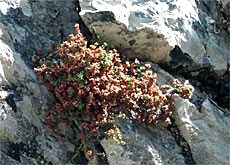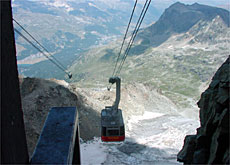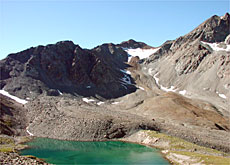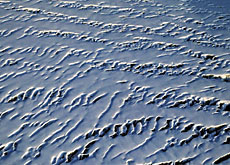Global warming threatens alpine plants

Melting glaciers are spectacular indicators of climate change, but when it comes to biodiversity in the Alps, scientists are more concerned about the fate of fragile mosses and flowers.
The effect of global warming on alpine vegetation was one of the main topics discussed at a recent climate conference in Grindelwald.
Scientist Georg Grabherr from the University of Vienna, one of the key speakers at the conference, confirmed that if global warming continued, Europe could see vegetation shifting north- and eastwards.
The conditions would be right, he said, for flora indigenous to countries bordering the Mediterranean to thrive in central Europe.
“There’s a probability that the trees and plants that are growing there could move or grow in our area,” Grabherr told swissinfo.
According to models of forest recovery after the last ice age, Grabherr said that dominant tree species moved northwards at an average rate of 200 metres a year.
Studies that he has conducted on alpine vegetation show that a shift is already occurring.
Grabherr says plants are also moving upwards in altitude, forced to flee by invading species, and ending up “pushed to the wall” on mountaintops.
“But the big question is, will southern plants manage to migrate north,” he added.
Temperature rise
Human population explosion coupled with urban development could prove to be an insurmountable barrier preventing a new northern migration.
“You reduce the capacity of plants to propagate if the habitat is already occupied or not available, as the situation is today where most habitats have been altered by human intervention,” explained Vera Markgraf of the Institute of Arctic and Alpine Research at the University of Colorado at Boulder.
Even without competition from foreign plants, alpine vegetation is threatened by a dramatic rise in temperatures and a lack of rain, as Europe experienced this summer.
“When we talk about biodiversity, we have to consider special habitats which can disappear quite quickly,” Grabherr said, referring to mosses and grasses that cling to chalky rock faces on the mountainsides above Grindelwald.
“This summer’s drought killed a lot of the grasses on the rocks where there is normally a lot of water,” he said.
The purple mountain saxifrage could die from “overheating” he said, adding that it would be a “curious” event in the “cold climate of the Alps”.
Preservation and protection
Markgraf said efforts to preserve or protect endangered alpine habits could prove futile.
“I don’t think we can tell conservationists where they should protect areas or plant trees because we can’t predict what will happen in climate terms and where habitats might be,” she said.
But according to Martin Beniston, the director of the geography unit at the University of Fribourg, progress is being made in predicting the effects of climate change.
“We’re moving ahead with further understanding of very complex interactions between climate, climatic change and the alpine environment,” he told swissinfo.
“Because the alpine region is so heavily populated there will be impacts on economic activities, so any further understanding of the way the environment will change in coming decades will help us, perhaps, to adapt to these changes,” he said.
“I think the summer we have just lived through is a little bit of the shape of things to come.”
swissinfo, Dale Bechtel in Grindelwald
The conference, “Climate Change: Impacts on Terrestrial Ecosystems” was a week-long, interdisciplinary meeting in Grindelwald (see links) organised by the Swiss National Science Foundation.
The topics included climate change and trends, species distribution, land use change and biological carbon sinks, and modelling biophysical ecosystem responses.
The annual conference, now in its third year, provides young scientists with the opportunity to learn from some of the world’s leading climate researchers.
The topic of next year’s conference, to be held near Locarno in southern Switzerland from August 29 to September 3, will be “Climate Variability: From Observation to Prediction”.

In compliance with the JTI standards
More: SWI swissinfo.ch certified by the Journalism Trust Initiative




You can find an overview of ongoing debates with our journalists here . Please join us!
If you want to start a conversation about a topic raised in this article or want to report factual errors, email us at english@swissinfo.ch.